Silly Noisy House
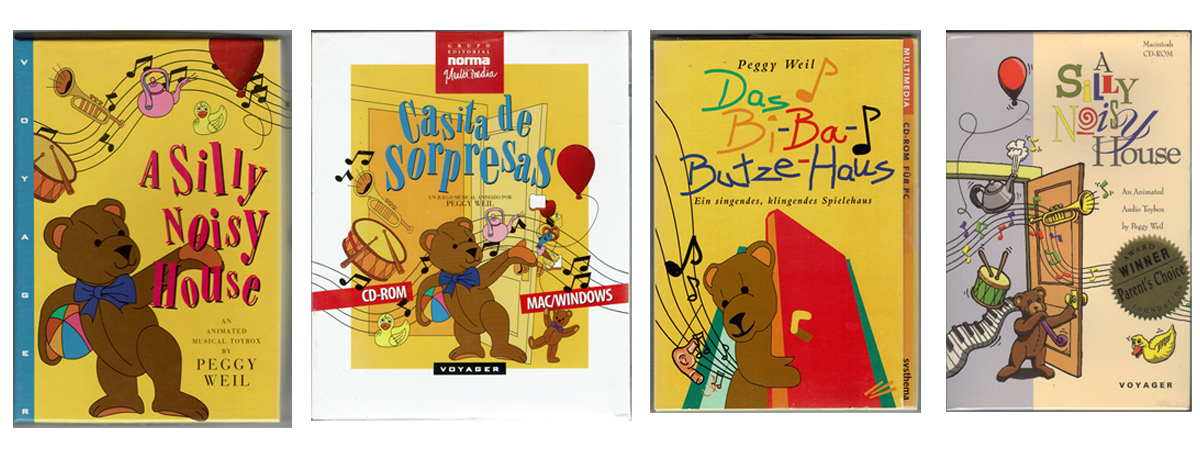
A Silly Noisy House
CD-ROM, The Voyager Company, 1991
A Silly Noisy House was of the very first interactive titles for children. The Voyager Company released it on CD-ROM in 1991 for color Macs. In 1991, there were so few color Macs with CD-ROM drives that Voyager’s press release included a videotape (most likely a VHS cassette) of my daughter playing in front of the computer, as no one could quite imagine what a child might do with a mouse. It was reviewed positively and won several awards (see below). During the decade that it was in print (for PC and Mac) it was translated into German (Das Bi-Ba-Butze Haus), Spanish (Casita de Sorpresas), Greek and Japanese.
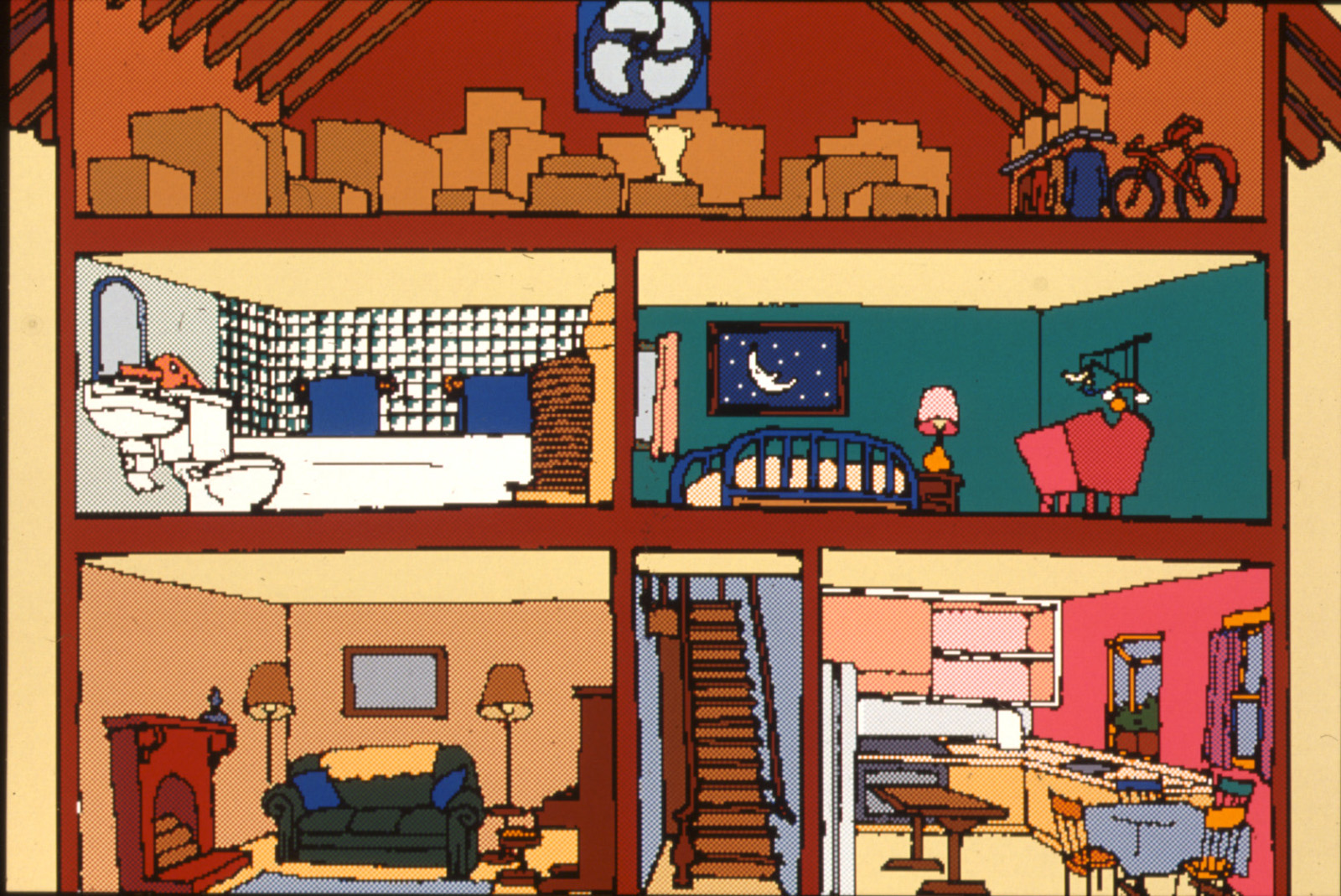
A Silly Noisy House, 1991
Background
I had approached Bob Stein, who had just founded The Voyager Company, to publish an original interactive work for laser disc. It was 1990, at the dawn of CD-ROM publishing. Bob invited me to create whatever I wanted with the following conditions: it had to be a product for children, it would have to be predominantly audio and require no licensed properties. These requirements were strictly business; the emphasis on audio rather than visuals reflected that high quality audio, could be produced at lower cost than quality animation. He specified a children’s product because it was both evergreen and a broader demographic than any specific topic for adults. There was simply no money for licensing.
I watched children play and decided to make a title based on an activity – the anchoring concept of interactive. What do kids already do that justifies interruption and participation? The conceptual model for A Silly Noisy House was a Music Box. Give a child, any child, a music box and she will play with it until they figures out what it is they have to do to get it to make sound and then they’ll figure out how to turn it off. Touch it – it makes a noise! Touch it again, the noise stops. Click on something, it makes a sound (or a noise or a song or a rhyme), click again and it stops. I think Bob thought I’d said toybox, and I somehow started with a chest of toys – but among the toys there was a dollhouse.
It all started with the KITCHEN. I made a number of Hypercard stacks with sketches for interaction and Brian Speight offered to draw the kitchen for me. He made the original drawing (eventually illustrating the entire project) with black marker on white tissue paper. We scanned the drawing and I borrowed a MacCorder and recorded everything in my kitchen that made noise, including tuning all the glasses to play a scale. Note the wine bottle on the table.
I eventually scored the kitchen to play Twinkle Twinkle Little Star by drawing lines from the notes to the objects in the kitchen – not without experimenting first with real glasses in my actual kitchen.
A Silly Noisy House is a celebration of household noise: the vacuum cleaner, blender and phone get equal play with the tongue-twisters, lullabies and music. The drumsticks beat on the walls and steps as well as the drum.
The Bears came later. I didn’t want to make a house with ‘nobody home.’ I consciously left the Bears nameless and unscripted. I spent a lot of time watching my children play with their dollhouse and saw how they made up their own names and dialogue for their dolls. I think it is important to leave children a space to pretend, to create a world and make up their own stories.
This was underscored one day when my daughter, who was four at the time, came up to the sandwich screen and said, “Mommy, which one are you?” Then, without waiting for me to answer she said, as she dragged the cake over to one of the bears and said, “I think you’re the one with the purple bow and I’m that other one and wouldn’t you like a piece of cake and I’m going to have some ice cream,” offering an ice cream cone to the other bear.
That’s when we added the small draggable bear. It resides in almost every room and can be moved around and clicked into a few standard positions. That bear is for kids to discover, drag around and make their own. Back offscreen, I was very happy one day when I saw my younger daughter standing in front of our real dollhouse, holding the teapot and singing “I’m a Little Teapot.”
The idea for the Teddy Bear’s Dream came from watching our daughters use “magic pads,” a surface with a special marker which reveals the picture underneath. I have a few favorite cues: that spring I’d had a problem with moths so I get special pleasure from the moths in the attic. I love the magic hatbox, Amanda Goodenough’s contribution. I recruited writer and performance artist Barry Yourgrow, for the tongue-twisters. I never get tired of “Betty Botter Bought Some Butter…” You might get a perfect reading or you might get a tongue-twisted one. When I was young I spent a great deal of time tapping on panels looking for a secret passages. After I watched children playing the test versions of A Silly Noisy House enjoy falling through the trapdoor in the attic, I added several more secret passages.
I teamed up with composer Daniel Stein for the sound effects and music. Inspiration for the trumpet fanfare came from a recording I had of a Chilean theatrical group that had performed in Santa Monica as part of the L.A. festival during the 1984 Olympics. I gave the cassette to Dan, asked for a fractured fanfare and he produced the signature opening. There are over 250 sound effects and fourteen songs.We celebrated the release of A Silly Noisy House at a party where we served a two-story scale model of the Silly Noisy House in gingerbread and gumdrops.
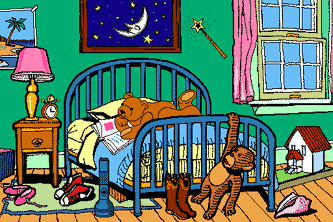
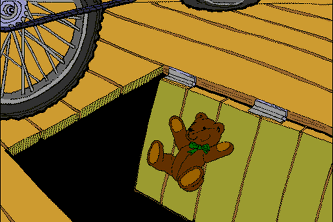

Interface Notes
The important innovations of A Silly Noisy House are not the specifics of the program, but the style of interaction and the integration of different media. I conceived of A Silly Noisy House as an animated musical pop-up book. The songs, nursery rhymes, sound effects, and music are “cached” inside the house for a child to discover. Open the oven and Four and Twenty Blackbirds fly out of the pie, open the refrigerator and the butter recites Betty Botter Bought Some Butter, or the jar of pickled peppers recite the Peter Piper Picked… The roar of a blender or whrrr of a vacuum cleaner are given equal time with the songs I’m A Little Teapot and It’s Raining It’s Pouring.
A Silly Noisy House is not a game. There is no goal, there are no advancement levels, it is not conventionally or commercially educational in that there are no gratuitous number and letter drills. It is a hybrid: a cassette tape plus a pop-up book plus a video with a few surprises. Different children play with it differently. They sing along, they find the activities, they talk to the bears (they invent conversations) they listen and hunt for new sounds. I learned that older children (six or seven and up) would approach it with the purpose of discovering every single cue. Once they’d exhausted an area, they’d had enough for that session but would eagerly go back later to revisit their discoveries. I’d programmed several possible responses for a click, so each trip would be slightly different. A very young child (three or four) would repeat activities, going back, over and over again, to one song, one rhyme, one animation. The next day, they’d find another favorite. Both age groups enjoyed showing their siblings, friends or caregivers what they’d discovered.
Designing an interface for young children requires simplicity and clarity. There is no reading, there are no dialogue boxes, there are no complicated instructions. WYCWYG – What You Click is What You Get.
HOME or the “Table of Contents” is a section cut showing the interior of a dollhouse. There are no arrows or buttons or words. Navigation is very simple: A physical dollhouse allows a child to physically enter a space as soon as she focuses her attention on a particular room. You enter a room in A Silly Noisy House with a click. The room appears and can be explored by clicking or panning right and left. Doors and passageways are entrances and exits. Each room has a small dollhouse on the floor, this house within the larger house takes us back to the section view of the entire house. There are a few magic passageways discovered via serendipity. There is no “back button” or “history.” No oops or Cnt-Z or ESC button because you can’t do anything wrong.
A Silly Noisy House broke ground in the area of copyright. In 1991 the Library of Congress was unprepared for digital media. Ken Liebman, an intellectual property attorney, offered help. He pressed on valiantly, calling one day to tell me that I would have to submit the entire computer code in order to obtain a copyright. A CD-ROM, unlike a book, doesn’t easily yield its contents (or didn’t at that time) so the librarians, more comfortable with paper and print made what they thought was a reasonable request. But what was I going to print? A Silly Noisy House was a confection of original drawings and animations, original performances of public domain material, and sound effects all held together within a composition of links described in a computer scripting language called LINGO annotating a score the multimedia authoring platform Macromind Director. (Support for LINGO and Director ended in 2017). The code, on paper, I protested, would be incomprehensible. It was to no avail, they had to have print. In the end, I submitted over six hundred pages of computer code and received my official copyright, a first for an interactive digital media product.
A Silly Noisy House, Das Bi-Ba-Butze Haus and Casita de Sorpresas are in the Stanford University Library Science History of Science & Technology Collections; Film and Media Collections
AWARDS
MacUser Top 40: 1993
New Media INVISION Awards: Silver Medal, 1993
L.A. Parent Magazine Software Award for Early Childhood, 1992
New York Time’s All Star List, 1992
A.V.A. Award, Tokyo, 1991
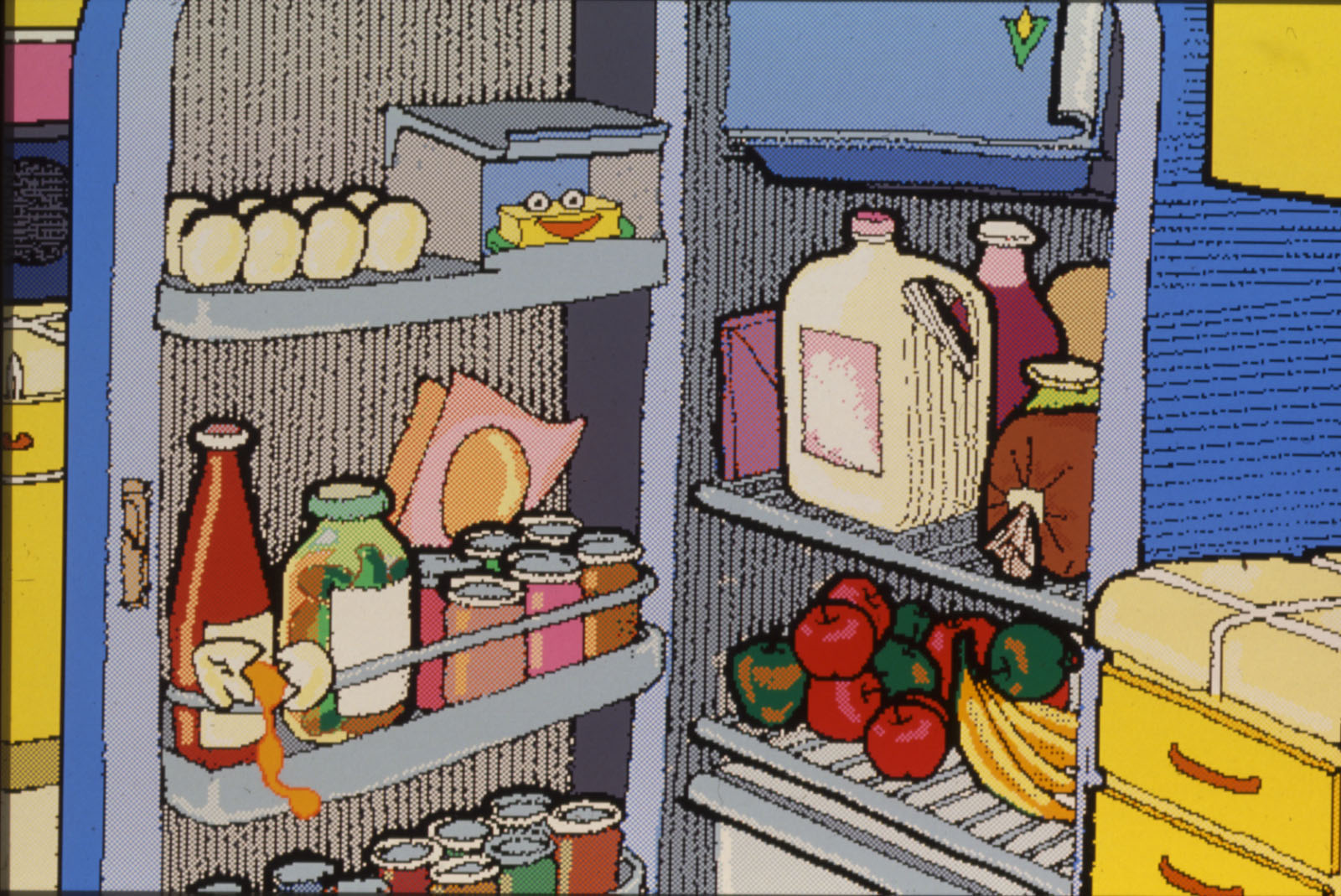
A Silly Noisy House, 1991
Uploaded video partial play-through of A Silly Noisy House on unrelated site.